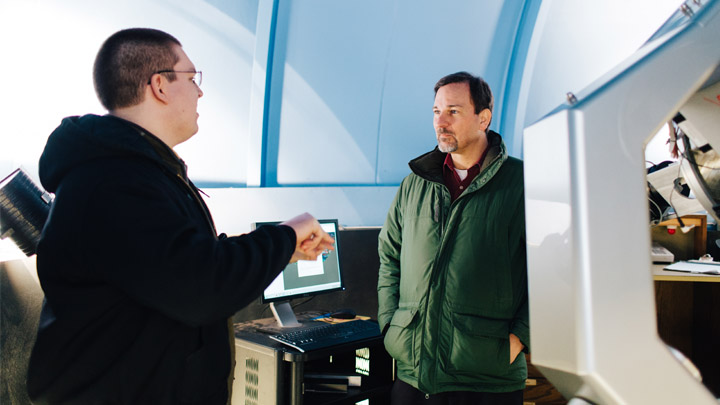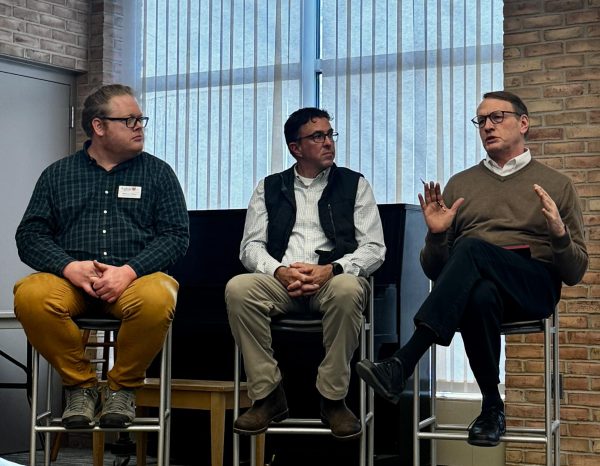Molnar’s star prediction featured in film
On Monday, Larry Molnar, Calvin astronomy and physics professor, gave his most recent talk about his now famous prediction: a converging, contact binary star. If the prediction comes true in 2022, he and the undergraduate students who have helped him will make history.
But Molnar wasn’t always a believer. When student Daniel VanNoord (‘14) first decided to look closer at a peculiar, flickering star, KIC 9832227, Molnar didn’t hold his breath, but let Van Noord continue his research.
“Frankly, I was very skeptical in 2013, though Dan was very confident, but the cool thing about science is that it doesn’t matter what you think or believe in that sense. It matters that you take the data and do the tests,” Molnar said.
At a conference in 2013, VanNoord and Molnar had learned about a particularly interesting star—one of thousands monitored by the Kepler Spacecraft. Actually two suns caught in the other’s gravity, the star’s cores orbit each other, causing the light to dim as one passes in front of the other.
Molnar describes the star as a peanut with “one common shell around them, but two distinct cores.”
VanNoord ran some numbers out of curiosity and discovered that the star showed signs that the two cores were on course to converge, resulting in an explosion. Molnar’s curiosity was piqued. Further research verified Van Noord’s hunch. The stars were approaching each other at an ever-increasing rate.
At the outset, many possibilities were on the table for the future of this star. Among them was the potential for a “third body” scenario: three stars in a gravitational dance, rendering similar data, but not resulting in an exploding collision. In the following years, Molnar and other undergraduate students continued to collect data, and other outcomes became less and less probable.
Close to the beginning of the project, Calvin film and media professor Sam Smartt, a documentarian, caught wind of Molnar’s project and began documenting his research, taking special interest in the fact that such a monumental discovery was potentially coming from a small, Christian liberal arts college. Smartt followed Molnar’s project to New Mexico where a larger telescope allowed for further monitoring of the star.
This past summer, Smartt was aided by McGregor and fellow Joel Riddering, a senior. When Riddering began, there were already 95 hours of footage from past years. So, he set to work organizing, marking the clips, skimming through for the best content.
Smartt and Riddering also traveled to interview faculty at three colleges on the topics of history, science and faith. The stops included The University of Iowa, where Molnar formerly served as faculty, The City College of New York and New York
University, Gallatin School of Individualized Study.
Smartt says that he hopes to convey to viewers that Christians doing science is not an anomaly, but, historically, has been commonplace.
“I’m trying to help realize that this isn’t a blind squirrel finds a nut situation. Christians can be very good scientists and sometimes their faith even helps them be better scientists,” he said.
Molnar sees his work as a scientist as valuable not only for the advancement of science, and also intrinsically worthwhile.
“God has made an incredible universe, ‘The heavens declare the glory of God,’ and I say that’s only useful if you’re listening,” he said, adding, “Not necessarily because [his research] is going to solve problems, because it’s not. But we live in a wonderful world. Let’s enjoy that wonder.”
However, Molnar also has aspirations for what his discovery could mean for society. If, in five years, the star explodes, it will be visible all across the northern hemisphere.
“I guess it’s my hope to showcase for people, everybody, how science really does work,” he said. He added, though, that regardless of whether he’s correct or not, he will publish his paper.
And for Smartt and Riddering, the film is just as much about the scientist as the discovery.
“As people, we identify with other people. We don’t identify with topics and issues,” Smartt said. “You begin to root for (Molnar) in the context of his journey, regardless of your persuasions, then that’s something that you have to grapple with in a different way.”
The Calvin Observatory, where Molnar and students conducted much of their observation of the star, is open on Wednesday nights at 7:30 p.m. or 30 minutes after sunset until 11 p.m.
More information about Smartt’s documentary can be found at luminous-film.com. The film does not have a set release date.







